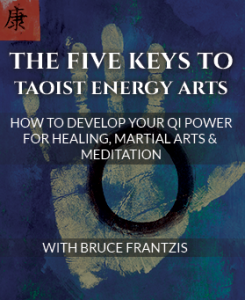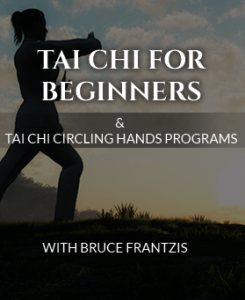There is an old Taoist saying, “The teacher leads you to the gate, but only you, by your own effort, can pass through.”
I would like to talk about what it means to ‘master’ tai chi and if that is even possible.
Chi (qi) practices are as important and essential to us as sleep, food and water. One of the hardest lessons in life for many is to learn how to nourish ourselves. While many of us will make time to nurture others with positive energy or care-taking, we often neglect our inner worlds.
We disregard the connection—within us and all around us—that keeps us balanced and alive. In so doing, we lose the ability to feel our chi. This often happens at a young age and is something that never gets reclaimed. But it does not have to be this way.
Where Do You Start?
You start with what you can do right now, right this minute. You will only have success with what you can stand to do, what you grow to love—exercises you can actually do, not what you should do. Taking one small step toward yourself right now will encourage you to take others. It will give you a foundation upon which to build. You will find it becomes increasingly easier to move from the basics you can do right now to the more advanced practices available to you.
Right now, take three breaths and use them as a measure of how you breathe. Or take three breaths and allow the breath to help you consciously relax. Slowly, you could build up to five minutes of relaxed, life-nourishing breathing each day.
If you start with one minute here, two minutes there, five minutes there, the effect on your nerves and chi is cumulative. You don’t have to start by doing everything all at once and, in fact, it is not recommended.
Your practice outlook should be a positive one, and doing too much too soon is a sure-fire strategy for failure. Your practice has to be sustainable. The point is, start somewhere right now. Something is better than nothing. Even if you only practice a few minutes here and there each day, you are supporting your choice to nourish yourself and your chi.
To learn more about Energy Arts’ Tai Chi for Beginners Program, please click here.
Don’t Leave Your Practice to Chance
The fact is, if you think a skill is worth having, then with practice all you can do is get better. Even though you might be capable of learning basic movements from a retreat, weekend workshop or video, it takes time for the movements to work deeply in your body, emotions and mind. If you practice, you will feel how tai chi, qigong, bagua, and yoga exercises change you on both gross and subtle levels.
As with any skill you develop, you first have to be willing to apply the beginner’s mentality:
- Repetition
- Getting feedback from those who already have the ability
- Building on easy successes and advancing only when you have the basics down pat.
Nobody Starts Out Being Great in a Day
When John Lennon started composing songs, he knew he had a passion and some talent. He put in the time and practice to develop his talent into the great songwriter he became. The same is true for internal chi exercises. Nobody starts by doing them perfectly. The experts will tell you that perfection is unreachable, a trait that is only reserved for gods.
I once asked my greatest teacher Liu Hung Chieh, “Have you ever done tai chi perfectly?”
He said that, one day after decades of practicing he thought he had. But then, he said, it was several weeks later when he suddenly realized he had done tai chi even better than the time before. Who knows how many times this happened…
Only a fool says, “Well, I have to eat three healthy meals a day and if I don’t, I’m not going to eat at all.” If you want to live in the real world with that attitude, get ready to starve. The perfectionist’s outlook for the vast majority is a failure’s strategy. Maybe if you are very wealthy you can take three hours a day to eat extremely well; however, most of us have to make compromises from time to time because it is the best we can do. Enough is enough. The same principle applies to establishing a time to practice.
For most of us, there will be no perfect situation, no perfect time to start nor a perfect place or circumstance.
The good news is that chi exercises can be done virtually anywhere, anytime—standing, sitting or even lying down. By harnessing the power of your chi, you take back control of your health and manage your stress so you are vital and energized for your life. Establishing a regular rhythm of practice is a big step. It will be worth it to you when you can look back and see how far you have come. Without your health, you cannot take pleasure in anything.
Carving out Practice Time
Whether you take a class or decide to learn chi practices from a DVD or a book, you need to carve out some time in your daily schedule that makes sense to you. If you are a disciplined person, this will be relatively easy for you, provided you place some value on it.
If not, setting a regular practice time, even for three to five minutes a couple of times each day, will make a tremendous difference for your long-term progress. Maybe take a few deep breaths when you become aware of negative self-talk, for example.
In only a few minutes, you will enable your nervous system to slow down, relax and allow your chi to flow uninhibited. Practicing regularly will benefit you more than not doing any chi practice during the week and trying to make up for it on the weekend. A little consistency is better than overdoing it every once in awhile.
Observe the 70 percent rule. Not overdoing your practice makes it easier to stick to it without trying to talk yourself out of it.
The best time to practice is sometime, rather than never. Maybe you find it easiest to practice in the morning when you first wake up; maybe you find it easier just after the kids go to bed. By starting with only that small regular rhythm, just those few minutes, you will most likely, and virtually effortlessly, start extending your practice a few minutes here and there. As you reinforce positive rhythms, they will physically solidify in the brain, recondition the body and powerfully strengthen and cultivate your chi.
Establishing Positive Inner Rhythms
Before any new practice can take hold inside you, a rhythm must be established in your body and central nervous system. Most people have deeply established rhythms: when they get up, eat, go to work, exercise. Integrating novel aspects into your rhythms is often difficult because the neural pathways and the corresponding, highly reinforced, conditioned responses in the body require reprogramming. Your brain and body will need time to make the new physical connections.
Each time you practice, however, you are strengthening these pathways so that you no longer have to think about what to do—you just do it.
Rhythms are established by repeatedly activating neural pathways in the brain, whether positive or negative. Chemical reactions in the brain, or neurotransmitters, reinforce positive or negative rhythms.
In many people, habits of self-neglect and negative patterns accumulate over long periods. One of those patterns is deep resistance to change. Many people find it difficult to reestablish healthier flows, particularly with regard to diet or exercise.
A common excuse is “I don’t have time.” What that usually indicates is the old conditioning of the brain taking over to suppress the need to evolve and change.
Whether you are learning in a class or on your own, it takes anywhere from three weeks to a month for your body to accustom itself to new practices and to have them take hold at the cellular level. Then, chi practices become as natural and important as eating or brushing your teeth.
In other words, a positive feedback loop is created, kicking in to help you maintain them when you meet internal or external resistance.
Chi Practices are Life Tools
Chi has the power to grow and strengthen inside you exponentially. After a certain amount of practice, which differs for everyone, the effects take hold and begin growing ever more quickly inside you. A small snowball grows into a large one as it rolls downhill, gathering momentum, size and strength.
Likewise, investing $1,000 earns a little interest at first, but after some years the interest and principle compounds and becomes $10,000.
Although chi practices are great for cultivating health and well-being, they can also be used when you have to deal with difficult situations. Maybe you know you’re going to face a tense situation at work or at home. Maybe the traffic is a nightmare, day after day. Maybe you’re sitting at your computer and you feel the strain building up in your hands and arms. When the internal chatter starts running in circles, havoc soon follows in your head, stomach and shoulder muscles.
This is the moment to start taking conscious breaths and focusing on relaxing and letting go. Release any blockages before they have time to bind inside you and create more trouble. Get up and do whatever chi movement exercise you know to get the chi flowing again.
The Magic of Chi
The power of chi is deeply transformative. Nourishing your chi will make you healthier and more relaxed for the rest of your life, well into old age. Chi work clears the physical blockages and negative emotions and thoughts, bringing back the joy and spontaneity you had as a child.
More advanced chi practices will help you connect strongly to yourself and will allow genuine love and compassion for yourself and others to flow naturally. As you open up to your human potential, the deep positive rhythms of the universe will come to your aid.
Chi practices can inspire you for the rest of your life. One of the most magical qualities I have found is that they continue to interest, engage and teach me new lessons, even after four decades of daily practice.
If you could choose to have more external or inner wealth, consider that an inner exploration to harness the chi flowing inside and through you is a true path to inner peace and happiness.
To learn more about Energy Arts’ Tai Chi for Beginners Program, please click here.






Thanks for all your posts about training, whether Qi Gong, or Tai Chi, it is appreciated, and very helpful.
Many thanks for your wise words I look forward to developing my Chi